Rod Miller's Blog, page 24
December 8, 2017
Lies They Tell Writers, Part 42: Know (and Follow) the Rules.

Many, many of the “lies” addressed in these parts have to do with the “rules” passed along to aspiring writers at conferences and workshops, in books and articles, by critique groups and manuscript readers. Most of the “rules” are based, in some part, on reality. But seldom are they universal enough in application to even qualify as “rules.” “Advice” or “considerations” would make more apt descriptions. The simple fact is, if you want to write, and write well, you have to figure it out for yourself. No one else can guide the pencil or stroke the keyboard or tell you how to tell your story. That’s not to say you should ignore the “rules” you hear. Neither should you accept them unconsidered or untested. Try that, and you’ll end up hopelessly confused, staring at a blank screen or sheet of paper wondering how to proceed and continually contradicting yourself as one “rule” clashes with another. I think the best advice concerning following the “rules” is that offered by W. Somerset Maugham: “There are three rules for writing a novel. Unfortunately, no one knows what they are.”
Published on December 08, 2017 07:26
December 1, 2017
Shameless commerce (and a freebie).

It’s that time of year. ’Tis the season when giving and getting are on everyone’s mind. And what better Christmas (or Hanukkah or Kwanzaa or Boxing Day) gift could there possibly be than a book. Or two or twelve.Being a writer of books, I hope, of course, you will consider giving my books as gifts. There are nonfiction books about the history of the West, novels of the serious and silly kind, short stories for short attention spans, and poems for even shorter attention spans. Enjoyable reading for folks from junior high to geriatrics. You’ll find information about them all at www.writerRodMiller.com and www.RawhideRobinson.com. If you hurry, you’ll have time to read them yourself before you give them away. But if you don’t finish in time for Christmas, Chinese New Year comes around February 16 in 2018, and it’s another fine opportunity to give a book as a gift. Happy holidays.
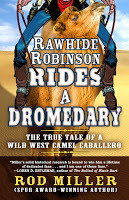
Enter by December 7 to win a free copy of Rawhide Robinson Rides a Dromedary: The True Tale of a Wild West Camel Caballero on Goodreads. Visit Rawhide Robinson Rides a Dromedary Giveaway and find the button marked “Enter Giveaway” and you’re in. But hurry. Rawhide Robinson waits for no man (or woman).
Published on December 01, 2017 07:56
November 25, 2017
My Favorite Book, Part 11.
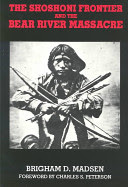
Since my long-ago college days I have had a more-than-passing interest in the history of American Indians. My shelves contain many books on the subject. But none has affected my research and writing more directly than The Shoshoni Frontier and the Bear River Massacre by Brigham D. Madsen.The book covers the history of the Northern Shoshoni from early contact with whites around 1840, until the ratification of treaties with the United States government in 1864. Included in the story, of course, are some 40 pages treating the Bear River Massacre, during which US Army troops slaughtered somewhere between 250 and 350 Indians—the worst massacre of Indians by the army in the history of the West. Included in the book is Shoshoni historian Mae Parry’s account of the massacre. That such a tragedy could be largely lost to history intrigued me. I set out to learn more about it, including the privilege of talking with the author, Brigham Madsen, on several occasions. Reading The Shoshoni Frontier and the Bear River Massacre led to my writing Massacre at Bear River: First, Worst, Forgotten as well as a chapter on the subject in my book The Lost Frontier: Momentous Moments in the Old West You May Have Missed , a short story, a magazine article, several poems, and even the lyrics to a song, “And the River Ran Red.”But it was not only the subject matter of the book that intrigued me. Besides being one of the West’s foremost historians and experts on American Indians, Madsen was a fine writer. This book, as well as the many others he wrote, is well worth reading.
Published on November 25, 2017 12:05
November 15, 2017
Were people in the Old West better than now?
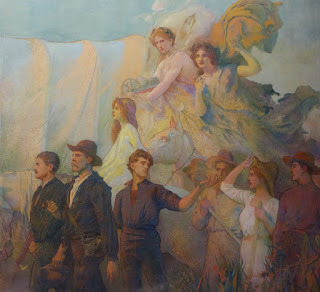
Many people I know—writers and readers and viewers alike—are of the opinion that people living in the Old West were somehow “better” than those of us walking the earth today. Back then, people didn’t use profanity. Honesty and square dealing ruled the day. Men placed women on a pedestal. Women were content in the kitchen and keeping house. Children were obedient, save occasional innocent hijinks. And while those were violent times, it was mostly good guys in white hats killing bad guys in black hats who needed killing. Truth, justice, and the American way ruled the day.Studying history—rather than reading novels and watching movies and TV shows based on celebratory mythology—will soon disabuse you of any notion that human nature was any different then than now. Or at any other time in the history of people, for that matter. Certainly social conventions change, but that only affects times and places of misbehavior rather than behavior itself. Back then, while men pretended to put “the fairer sex” on a pedestal, wives were little more than chattel, and could be beaten with little or no consequence. Ladies of the evening were routinely mistreated, with abusers considering violence included in the price. Alcoholism was rampant, drug abuse widespread. Child labor routine. Mistreatment of minorities acceptable, even encouraged. And so on.The only real difference between then and now is that bad behavior often occurred behind closed doors in those days, and was little noted. Unseen, but there all the same. Now, it fills our TV screens and newspapers day and night. Our blind spot concerning the evil in days gone by reminds me of the poem “Antigonish” by William Hughes Mearns. It begins this way:
Yesterday upon the stair I met a man who wasn’t there He wasn’t there again todayI wish, I wish he’d go away.
Published on November 15, 2017 07:36
November 5, 2017
Cultured cowboy.

Cowboy culture is a thing unto itself. Not to be confused with “high culture” associated with high society and such. In fact, the two worlds are, for all practical purposes, in different orbits altogether and seldom cross paths.But, every now and then, something happens that makes you realize they’re not really all that far apart after all.It happened to me recently. Being big fans of cowboy singer Dave Stamey, my wife and I wandered down into central Utah for a concert not long ago. Which is not unusual, given that we’ve sat in the audience at a lot of his performances.But what was unusual this time was that the artist—usually a solo performer—had a backup band: the Snow College symphony orchestra.So, as Dave picked his guitar and crooned his cowboy tunes, he was accompanied by a string section, woodwinds, brass, and percussion instruments, all harmonizing in beautiful arrangements of songs written by Dave, along with a few Western standards. It was a sight to behold (or should I say “be heard”?). The power of Dave’s music intensified with the orchestration, leading to a new appreciation of his songwriting, singing, and strumming skills. It was a night to remember. And I didn’t even have to wear a tie.
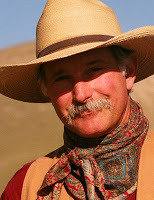
Cowboy songwriter and singer Dave Stamey
Published on November 05, 2017 08:36
October 26, 2017
Re-Ride Stories.
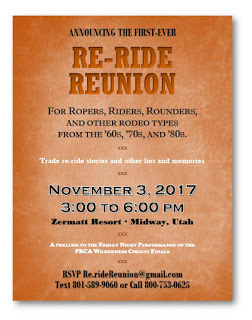 When rodeo cowboys hang out, conversations often turn to “re-ride stories.” Sometimes true, often embellished, occasionally fabricated, and usually humorous, re-ride stories recount rodeo adventures. Actual re-rides, wrecks, bad luck, great performances, road adventures…the subjects are many and varied. But one thing’s for sure—rodeo folks like a good story, even if they themselves come off looking foolish in the telling. And rodeo folks are not immune to the “The older I get the better I was” phenomenon among humans, so the stories, over time, sometimes take on lives of their own.As the years pass, many rodeo folks drift away from the arenas of their youth as lives travel different paths. But the memories linger. And so does the longing to, and enjoyment of, recounting that life and telling those stories, especially to an appreciative and understanding audience.That’s why I’m looking forward to the Re-Ride Reunion. On November 3, from 3:00 to 6:00 p.m., all rodeo folks from ’60s, ’70s, and ‘80s are invited to gather at the Zermatt Resort Hotel in Midway, Utah. We’ll re-connect with long-lost friends, renew old acquaintances, and, mostly, revisit days gone by.Afterward, most will probably make the short drive down the road to Heber City for the Friday night performance of the PRCA Wilderness Circuit Finals to witness the birth of another go-round of re-ride stories.I know there are some in the Intermountain West who read this stuff who would love to hear some re-ride stories, and have some of their own to tell. Learn more on Facebook. See you there.
When rodeo cowboys hang out, conversations often turn to “re-ride stories.” Sometimes true, often embellished, occasionally fabricated, and usually humorous, re-ride stories recount rodeo adventures. Actual re-rides, wrecks, bad luck, great performances, road adventures…the subjects are many and varied. But one thing’s for sure—rodeo folks like a good story, even if they themselves come off looking foolish in the telling. And rodeo folks are not immune to the “The older I get the better I was” phenomenon among humans, so the stories, over time, sometimes take on lives of their own.As the years pass, many rodeo folks drift away from the arenas of their youth as lives travel different paths. But the memories linger. And so does the longing to, and enjoyment of, recounting that life and telling those stories, especially to an appreciative and understanding audience.That’s why I’m looking forward to the Re-Ride Reunion. On November 3, from 3:00 to 6:00 p.m., all rodeo folks from ’60s, ’70s, and ‘80s are invited to gather at the Zermatt Resort Hotel in Midway, Utah. We’ll re-connect with long-lost friends, renew old acquaintances, and, mostly, revisit days gone by.Afterward, most will probably make the short drive down the road to Heber City for the Friday night performance of the PRCA Wilderness Circuit Finals to witness the birth of another go-round of re-ride stories.I know there are some in the Intermountain West who read this stuff who would love to hear some re-ride stories, and have some of their own to tell. Learn more on Facebook. See you there.
Published on October 26, 2017 07:08
October 16, 2017
Where have you been?

My travels of late can’t begin to match country singer Hank Snow’s list of stopovers in the classic 1962 hit, “I’ve Been Everywhere.” Still, I haven’t been sitting still.In late September I spent an enjoyable couple of days spouting off about creative nonfiction, poetry, historical fiction, and Western writing at the Idaho Writers League annual conference. I have presented at several IWL conferences over the years, and it’s always a pleasure. LaDean Messenger, president of the Pocatello chapter, ramrodded the event and made it a success, just as she has in years past when it’s been Pocatello’s turn.In early October, I made my way across the Salt Lake Valley (not always easy) to the Salt Lake Community College main campus for the two-day League of Utah Writers annual conference. Not quite as intimate as the Idaho event (with more than 400 attendees), but I still enjoyed speaking to aspiring and accomplished writers on improving prose by employing poetic techniques, writing opening lines that grab readers, and writing poetry. The following weekend found me 100 or so miles from home at the west campus of Snow College in Ephraim, Utah, for the Write Here in Ephraim conference. Another enjoyable event, where I got to hang out with writers and teach a workshop on using humor in fiction as well as one based on the popular “Lies They Tell Writers” posts that appear here from time to time.I haven’t been everywhere, but that’s some of the places I’ve been lately. Like my old Daddy always used to say sometimes, “Everybody’s got to be someplace, so you might as well be somewhere.” And here I am.
Published on October 16, 2017 10:14
October 1, 2017
Lies They Tell Writers, Part 41: Plan on Rejection.

You hear the stories all the time: How famous author so-and-so’s first novel, which went on to become a best seller and a classic, received forty-eleven-hundred rejection letters from publishers before finally getting published. Don’t plan on it happening to you.Your book may go on to be a classic, but it’s unlikely you’ll get many rejection letters along the way. That’s because what once was true is seldom the case anymore. In days gone by, publishers routinely sent rejection letters to aspiring authors. Some were boilerplate one-size-fits-all form letters, others offered actual criticism of the book, reasons why it was not a good fit for that publisher, even encouragement and advice. But, except on rare occasions, those days are gone.Queries and submissions today are met, more often than not, with silence. Most large publishing houses are staffed by a fraction of the number of people they were in the past, and those still on the job don’t have—or won’t take—the time to respond to—reject—your work. Smaller publishers are often shoestring operations and the owner-publisher-editor-designer-distributor-chief cook and bottle washer has too many pies and not enough fingers to reject every (or any) submission that comes along. This is true for unsolicited queries and submissions, but also, in many cases, applies when you’ve been invited during an interview at a conference or workshop to submit. You’ll get much the same treatment from literary agents. Unanswered queries are also the norm nowadays at periodicals.Still, if you don’t submit or query, you’ll never get anywhere so you’ve got to do it. Just don’t bother steeling yourself for the heartbreak of being rejected. More likely, you’ll simply be ignored. Which I find even more disheartening.
Published on October 01, 2017 08:33
September 14, 2017
My Favorite Book, Part 10.
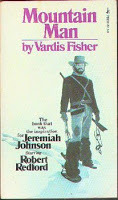
Mountain Man by Vardis Fisher is the story of Sam Minard, a young man who leaves the settled parts of America to make his way as a free trapper in the West. Borrowing from both fact and legend of the era, Minard is loosely based on John “Liver-Eating” Johnston, and Fisher includes the disturbed widow for whom Crazy Woman Creek was named in the story. Minard takes a Flathead woman for a wife and fathers a child, but while he is away trapping, Crow Indian warriors kill his family. The mountain man turns Crow hunter, tracking down and killing every man of the tribe he finds, which results in his being hunted by his Crow foes in an ongoing and bloody feud. All that is well and good, and for the most part the story the book tells is not much different from other mountain man and fur trapper tales. What I like best about Mountain Man is Fisher’s lyrical language and rich imagery. I get cold and hungry every time I read the book; at other times I feel well fed and comfortable. He writes a romantic version of life in the Old West, but he romanticizes it beautifully.The book was the basis (along with other sources) for a fine movie, Jeremiah Johnson, starring Robert Redford. It’s a good movie. But, as is usually the case, it’s a better book.
Published on September 14, 2017 08:32
September 5, 2017
Rawhide Robinson spills the beans.
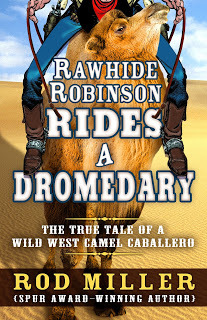
There are plenty of people who interview authors. You can learn a lot about writers and their writing from what they have to say. But author and publisher Kathryn Jones takes a different approach. She interviews characters from books. It’s an interesting and revealing approach, and leads to some remarkable revelations. Not long ago, Kathryn interviewed the extraordinary ordinary cowboy Rawhide Robinson. You can read the results on her site. Kathryn also graciously allowed Rawhide Robinson to post the interview on RawhideRobinson.com. Read all about it, and see what Rawhide Robinson has to say for himself.
Published on September 05, 2017 07:52



